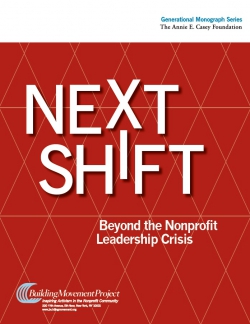Next Shift: Beyond the Nonprofit Leadership Crisis
Since 2007, there has been a rising sense of alarm in the nonprofit sector about the future of its leadership. Study after study pointed to an impending crisis, with roughly 75 percent of executive directors/CEOs reporting that they plan to leave their jobs within the following five years. Concerns about how to identify new leaders and issues of workforce development became high priorities for those thinking about the sector’s future. Recommendations have ranged from preparing groups for executive transitions to a mass recruitment of new talent from other sectors to discussions of leadership expansion. Since then, a new field of executive transition services has emerged, and many groups are seeking ways to increase the visibility and desirability of working in nonprofit organizations.
However, there has been another view emerging. From this perspective, it is the nonprofit sector itself that is in crisis, and the emphasis on leadership transition reinforces rather than challenges the prevailing issues facing nonprofit organizations. In talking with current and emerging nonprofit leaders in their 20s, 30s, and early 40s in numerous interviews, focus groups, and meetings, we found these younger (post-Baby Boom-age) leaders want to work with older generations to look at the causes and forces that have shaped the sector and the broader environment today and plan what future directions we should pursue. For younger leaders, the next decades will mean a different type of sector, with a different kind of leadership, one that will build on and move forward from that which exists today.
This paper argues that the commonly held “crisis” frame unnecessarily constrains how we think about the generational shift in nonprofit leadership, and like all frames, shapes what we view as appropriate solutions and strategies. Specifically, this current frame drives our attention too quickly to issues related to the leadership pipeline and leader replacement.
We believe a broader view of the issue is appropriate and needed. As Baby Boom leaders leave, the sector will approach an important turning point ripe with both challenges and opportunities. It is critical that we muster our broadest, most creative, and incisive thinking to understand and respond to this particular historical moment. Too many nonprofit agencies, and particularly the human services organizations that serve children and families, operate today under crushing political and resource stresses. Many larger agencies founded in flusher eras are struggling to adapt to an increasingly austere funding environment with demands for increasing accountability. Smaller grassroots groups fight to survive from grant to grant. At stake are the lives and life chances of tens of thousands of children, families, and individuals who receive support and services from these groups. This troubling prospect, we hope, will motivate all of us—younger and older leaders—to come together to chart common and effective strategies for the future.

